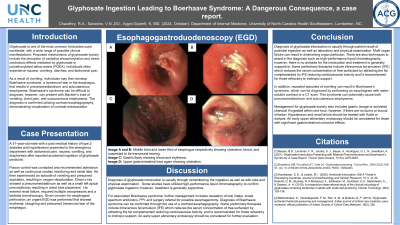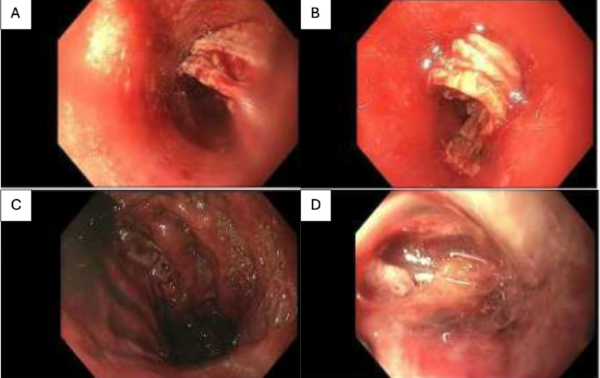Tuesday Poster Session
Category: Esophagus
P3960 - Glyphosate Ingestion Leading to Boerhaave Syndrome: A Dangerous Consequence
Tuesday, October 29, 2024
10:30 AM - 4:00 PM ET
Location: Exhibit Hall E

Has Audio

Dr. Valentina Saracino, DO
UNC Health Southeastern
Lumberton, NC
Presenting Author(s)
Dr. Rehman Chaudhry, DO, Dr. Valentina Saracino, DO
UNC Health Southeastern, Lumberton, NC
Introduction: Glyphosate is one of the most common herbicides used worldwide, with a wide range of possible clinical manifestations. Proposed mechanisms of glyphosate toxicity include the disruption of oxidative phosphorylation and direct cardiotoxic effects mediated by glyphosate or polyethoxylated tallow amine (POEA). Individuals often experience nausea, vomiting, diarrhea, and abdominal pain.
As a result of vomiting, it is not uncommon for individuals to develop Boerhaave syndrome, a transmural tear in the esophagus, that results in pneumomediastinum and subcutaneous emphysema. Boerhaave’s syndrome can be difficult to diagnose, however, can present with Mackler’s triad of vomiting, chest pain, and subcutaneous emphysema. The diagnosis is confirmed utilizing contrast esophagography that will demonstrate visualization of contrast extravasation.
Case Description/Methods: A 51-year-old male with a past medical history of type 2 diabetes and hypertension presented to the emergency department with abdominal pain, nausea, vomiting, and diaphoresis after reported accidental ingestion of glyphosate pesticide.
Poison control was contacted and recommended admission as well as continuous cardiac monitoring, and serial labs. He then experienced an episode of vomiting and presumed aspiration, resulting in oxygen desaturation. Chest x-ray showed a pneumomediastinum as well as a small left apical pneumothorax resulting in chest tube placement. He entered renal failure, required multiple vasopressors and a bedside bronchoscopy. Given concern for esophageal perforation, an urgent EGD was performed that showed erythema, sloughing and presumed transmural tear of the esophagus.
Discussion: Diagnosis of glyphosate intoxication is usually through remembering the ingestion as well as laboratory and physical examination. For associated Boerhave syndrome, further management includes cessation of oral intake, broad spectrum antibiotics, PPI, and surgery referral for possible esophagectomy. High-performance liquid chromatography may assist diagnosis, however, treatment is generally supportive. Some preliminary therapies include intravenous fat emulsion (IFE) which reduces the serum concentration of free surfactant by attracting the fat complemented reducing cardiovascular toxicity, and is recommended for those refractory to inotropic support. An early upper alimentary endoscopy should be considered for further evaluation.

Disclosures:
Dr. Rehman Chaudhry, DO, Dr. Valentina Saracino, DO. P3960 - Glyphosate Ingestion Leading to Boerhaave Syndrome: A Dangerous Consequence, ACG 2024 Annual Scientific Meeting Abstracts. Philadelphia, PA: American College of Gastroenterology.
UNC Health Southeastern, Lumberton, NC
Introduction: Glyphosate is one of the most common herbicides used worldwide, with a wide range of possible clinical manifestations. Proposed mechanisms of glyphosate toxicity include the disruption of oxidative phosphorylation and direct cardiotoxic effects mediated by glyphosate or polyethoxylated tallow amine (POEA). Individuals often experience nausea, vomiting, diarrhea, and abdominal pain.
As a result of vomiting, it is not uncommon for individuals to develop Boerhaave syndrome, a transmural tear in the esophagus, that results in pneumomediastinum and subcutaneous emphysema. Boerhaave’s syndrome can be difficult to diagnose, however, can present with Mackler’s triad of vomiting, chest pain, and subcutaneous emphysema. The diagnosis is confirmed utilizing contrast esophagography that will demonstrate visualization of contrast extravasation.
Case Description/Methods: A 51-year-old male with a past medical history of type 2 diabetes and hypertension presented to the emergency department with abdominal pain, nausea, vomiting, and diaphoresis after reported accidental ingestion of glyphosate pesticide.
Poison control was contacted and recommended admission as well as continuous cardiac monitoring, and serial labs. He then experienced an episode of vomiting and presumed aspiration, resulting in oxygen desaturation. Chest x-ray showed a pneumomediastinum as well as a small left apical pneumothorax resulting in chest tube placement. He entered renal failure, required multiple vasopressors and a bedside bronchoscopy. Given concern for esophageal perforation, an urgent EGD was performed that showed erythema, sloughing and presumed transmural tear of the esophagus.
Discussion: Diagnosis of glyphosate intoxication is usually through remembering the ingestion as well as laboratory and physical examination. For associated Boerhave syndrome, further management includes cessation of oral intake, broad spectrum antibiotics, PPI, and surgery referral for possible esophagectomy. High-performance liquid chromatography may assist diagnosis, however, treatment is generally supportive. Some preliminary therapies include intravenous fat emulsion (IFE) which reduces the serum concentration of free surfactant by attracting the fat complemented reducing cardiovascular toxicity, and is recommended for those refractory to inotropic support. An early upper alimentary endoscopy should be considered for further evaluation.

Figure: Image A and B: Middle third and lower third of esophagus respectively showing ulceration, blood, and suspected to be transmural tearing.
Image C: Gastric Body showing blood and erythema.
Image D: Upper gastrointestinal tract again showing ulceration.
Image C: Gastric Body showing blood and erythema.
Image D: Upper gastrointestinal tract again showing ulceration.
Disclosures:
Dr. Rehman Chaudhry indicated no relevant financial relationships.
Dr. Valentina Saracino indicated no relevant financial relationships.
Dr. Rehman Chaudhry, DO, Dr. Valentina Saracino, DO. P3960 - Glyphosate Ingestion Leading to Boerhaave Syndrome: A Dangerous Consequence, ACG 2024 Annual Scientific Meeting Abstracts. Philadelphia, PA: American College of Gastroenterology.
